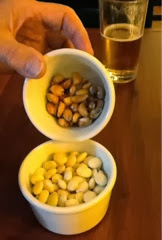In Cotacatchi today we stopped in at the Serendipity cafe owned by Tommy, a world traveller who owns two suitcases, three saxaphones, the cafe and three passports. "I can pack at a moment's notice," he said.
Where are you from in Canada?" he asked. "Near Toronto," we said, figuring he was American. "I'm most comfortable in Europe," he said. "But I lived for a long time in B.C.s Slocan Valley and did a lot of historical restoration in Nelson in the 70s." I bet he was a draft dodger, I thought. "Were you from the States at one point?" I asked. "From Hawaii," he said.
We learned a lot from Tommy about the cost of living here and how to immigrate from the States or Canada. It takes about three years to obtain residency papers. Apartment or house rental is $400-500/month, including all services, even phone. If you happen to be over 65, you can fly within and outside the country at a 50% airfare reduction. A 12% sales tax is applied to all purchases here.
But if you are a senior and save all your receipts, 50% of the sales' tax is returned. That's a substantial amount of money if you are building a house." You've got to visit several times and live here for at least four months or so before deciding to move here." Tommy said. "Many people make rash decisions to relocate, build homes and regret later. No one should expect to assimilate." Tommy is fluent in Spanish, German and Portuguese.
We ran into a lot of Americans at the cafe. Some spoke a little Spanish. Almost all were there because they had a hard time making ends meet in the States. Some admitted they wanted to escape the States's politics and current issues.
Cotocachi Cayapas Ecological Reserve
The Cotapachi volcanic crater is about 15 minutes outside of town.
A tribe of Cayapa Indians lives in this reserve of volcanic lakes, waterfalls plant and animal species. Besides more than 500 species of birds and 2000 types of plant life, there are anteaters, ocelots, foxes, raccoons, parmo wolves, sloths and deer fish and other creatures.
In the early 1990s a mineral surveying program partly funded by the World Bank intended to develop extraction industries here. Protests against publication of mineral deposit maps and mining in the the reserve's southwest cloud forest area have been successful so far.
I hope the world can protect this area because it is one of the planet's rare unfarmed regions and also because it contains a small remaining corner of cloud forest that stretches from southern Panama to northern Peru.
The Imbabura Volcano.
Finally some good coffee and real cream. It comes from the top of a bottle of milk. It's not whipped. Maybe it's clotted.
You might wonder why I'm taking photos of coffee machines and grinders. Well some cafes have the machines. But the coffee is vile. Either they don't know how to use the machines or all the good coffee is exported. I can't believe how much I've missed the stuff. It's amazing how you often don't know the importance of things (and people) in your life until they are gone.
Nescafe is everywhere.
Motorcycles, sound systems and sometimes wine are cheek by jowl in the same store.
A church along the way.
Tomorrow is our last day in Otavalo. Tuesday morning we leave for Quito and the last leg of our adventure. My backpack will be on my lap and not on the floor this time.
Hasta luego.




































































